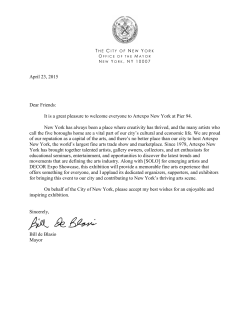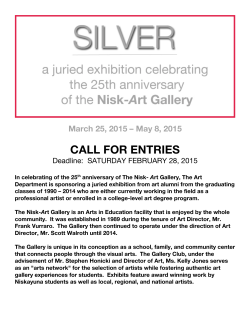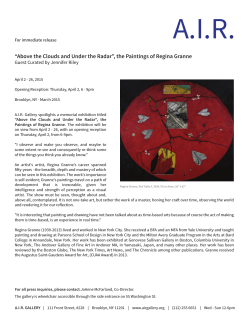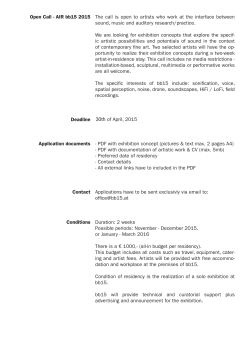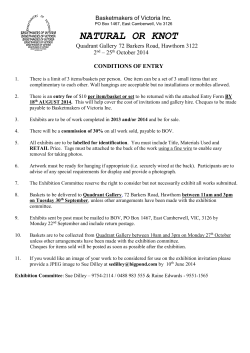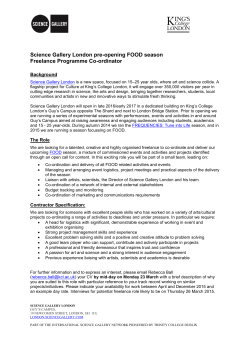
Behold Continues to Retreat
PRESS RELEASE Behold Continues to Retreat Curated by Mark Titchner 27 May – 4 July 2015 Including works by Albert, Anna Barriball, Anthony Green, Barrington, Chantal Joffe, Dan Duggan, David Musgrave, David Beales, Ewan Gibbs, Matthew, Paul Noble, Peter White, Raymond, Sam Sakya. ‘Behold Continues to Retreat’ is an exhibition curated by Mark Titchner that combines artworks depicting uninhabited rooms, buildings and landscapes with a series of portraits and works that explore the representation of the face. These distinct groups of works are presented in opposition to each other each occupying half of the gallery space. Portraits staring into landscapes and landscapes absorbing their gaze. The eye’s migration and back again. Bringing together Bethlem Gallery artists, renowned contemporary artists and works from the Bethlem Museum art collection the exhibition will explore the experience of creating, observing and being observed. The gallery invited artist Mark Titchner to guest curate this exhibition, to bring together artists from different backgrounds and experiences to explore common creative ground and bring different communities of artists together on an equal footing. Mark explains “In developing the idea for this exhibition I was struck by a description of the work of Bethlem artist Albert. Albert, whose work is included in the exhibition, produces stark, geometric pencil drawings which depict uninhabited spaces and architecture. One interpretation of these works would be that they depict threatening, institutional spaces but instead the artist’s intention was to depict spaces within which he felt comfortable and to bring them to life.” These spaces are empty in order to invite us in to them. Another Bethlem artist Dan Duggan, again included in the exhibition and working with pencil, produces heavily rendered portraits that repeatedly depict the same rudimentary face. These faces appear in different stages of construction or disintegration perhaps missing a mouth or the crown of the head but always with glaring eyes fixing the viewer. These works do propose an interesting question. How does one portrait stare more than another? If Albert’s landscapes long to be filled what do these eyes invite? Do they ask us to empathise or do they confront us? Do they beckon us in or warn us away? It is this projection of the artist or the viewer into an imagined space or physiognomy that is the crux of this exhibition. Of what is projected and of what is left behind. What response does an empty landscape elicit in the viewer that is different from the experience offered by a depiction of a face? Do we respond specifically to individual works or do we follow predetermined patterns that these genres demand. Does a landscape demand a pair of eyes upon it? “So with this in mind, my proposition for this exhibition was that each empty landscape should be offered the unblinking gaze of a portrait and in turn each portrait should be provided a world for those eyes to fill. “Or : If an artworks nature resides in its completion by a notional gaze or space what happens when that notional gaze or space is offered by another artwork that in turn demands a notional gaze or space to complete it?” Says Mark. Gallery Director Beth Elliott says “Mark has been supporting and promoting the arts at Bethlem for several years. He has had a long-term interest in the historic collections and holds our contemporary artists in high regard. It’s been a pleasure working with him on this project.” The Bethlem Gallery is situated on the grounds of The Bethlem Royal Hospital, the oldest psychiatric hospital in the world still functioning today. The small artist-led team that runs the gallery works with individuals to develop their practice and professional opportunities, by making time, space, resources and support available. Collectively we strive to develop the careers, experience and expertise of the gallery artists by creating opportunities for professional development during a person’s time in hospital and beyond. Our successful artist- in-residence projects also work with patients and staff on site to improve the experience of the hospital environment. The gallery works with a broad range of artists and art practices. It provides a space for high-quality artwork and a platform for experimentation, collaboration and skills exchange. The exhibition will provide the setting for this year’s Creativity and Wellbeing Week, hosted by London Arts in Health Forum. On the 6th June there will be a round table discussion with Mark, Iain Sinclair and Bethlem Gallery staff and artists. Booking available via the Creativity and Wellbeing website. Opening Event: 27 May, 3 - 5pm Exhibition continues: 28 May - 4 July Opening times: Wed - Friday, 10am – 5pm Gallery and museum open the first and last Saturdays of the month 10am - 5pm. Join us for a round table discussion with artist Mark Titchner and writer Iain Sinclair to launch Creativity and Wellbeing Week 2015 on Saturday 6th June hosted by London Arts in Health Forum. Address: The Bethlem Gallery, Bethlem Royal Hospital Monks Orchard Road, Beckenham, Kent, BR3 3BX Travel: Nearest British Rail: Eden Park / East Croydon Contact: Beth Elliott, Gallery Director, 020 3228 4101 Email: thebethlemgallery@gmail.com Website: www.bethlemgallery.com Notes to editors: 1. The Bethlem Gallery was established in 1997 to provide a professional platform for artists who are current or former patients of South London and Maudsley NHS Foundation Trust. Exhibitions and events are programmed throughout the year presenting a wide range of media and contemporary practice. Our annual programme incorporates collaborations with the Bethlem Museum, artists-in-residence, interdisciplinary research, and partnerships with arts organisations across the UK and beyond. We campaign for access to the arts in healthcare environments, and engage audiences in learning and debate on the subject of mental health. The Bethlem Gallery is funded by the Maudsley Charity. They support mental health and wellbeing by investing in projects that aid innovation in health services; training and education; and research and infrastructure. For more information visit: www. maudsleycharity.co.uk 2. In 2015 the Bethlem Gallery, together with the Bethlem Museum, moved to a new venue situated in the original administration building on the hospital site. The building has been radically redesigned to contain exhibition spaces for the museum’s prestigious collection and a contemporary exhibition space for artists practicing today. The space opened to widespred acclaim and aims to be the UK’s leading arts and learning space for mental health. In the vastly increased exhibition spaces, you will now be able to view centuries of significant historic artworks and objects together with inspiring contemporary artworks by current artists and service users. The new building is open to the public and free of charge. For more information visit: www.bethlemgallery.com 3. Mark Titchner was born in Luton but now lives and works in Southwark. He studied at Central Saint Martins College of Art and Design, London and was nominated for the Turner Prize in 2006. Mark’s work explores the tensions between the different belief systems that inform society, be they religious, scientific or political. His work is held in the permanent collections of South London Gallery, United Kingdom Government Art Collection and Tate. 4. Bethlem Royal Hospital is the oldest psychiatric hospital in the world and is a provider of mental health and substance misuse services for people locally and specialist services for people from across the U.K. For more information on our services please visit: www.slam.nhs.uk 5. 1 in 4 people will experience a mental health problem in any given year. This is the most commonly quoted statistic, and the one which has the most research evidence to support it - www.mind.org.uk Around 300 people out of 1,000 will experience mental health problems every year in Britain 230 of these will visit a GP 102 of these will be diagnosed as having a mental health problem 24 of these will be referred to a specialist psychiatric service 6 will become inpatients in psychiatric hospitals. 7. Interviews with the artists can be arranged and high resolution jpegs are available 9. A series of workshops will be run as part of the exhibition programme and is free and accessible for all.
© Copyright 2025

